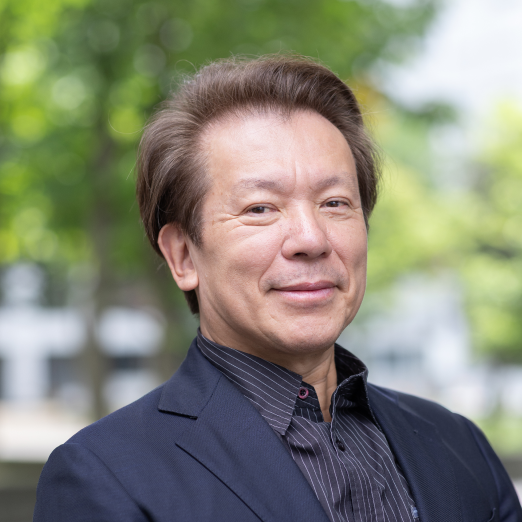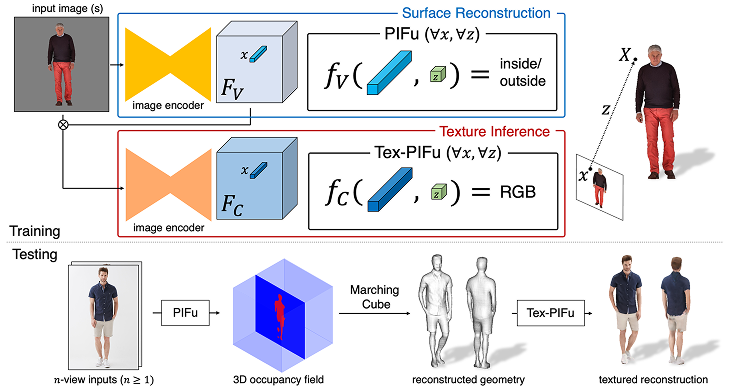
森島 繁生 教授
Shigeo Morishima
専門分野
知能情報処理工学
物理学を応用して人々に幸福をもたらす技術への挑戦
研究テーマ
人工知能 / コンピュータグラフィックス / コンピュータビジョン / ヒューマン・コンピュータインタラクション / 音楽・音響情報処理
キーワード
ニューラルフィールド, デジタルヒューマンモデル, 流体シミュレーション, 高速レンダリング, 深層学習基礎, 拡散モデル, ディープフェイク検出・破壊, 視覚障碍者支援, XR, 音楽自動採譜, 楽曲推薦, オーディオビジュアル情報処理, 演奏動画自動生成, アニメ線画自動彩色, アニメ中割画像自動生成
LINKS
RESEARCH OVERVIEW
研究概要
物理学を応用して人々に幸福をもたらすこと、安全・安心な社会、豊かな生活、日本の伝統文化などあらゆる面で、先端技術を通して貢献するというのが、森島研の研究目標です。あくまで最終のターゲットは人間の幸福や豊かな感性・文化に向けられているというのが特徴であり、研究者の自己満足に終わらせないことが重要なスタンスです。具体的には、物理、数学を道具だてとして使いこなし、ディジタル信号処理(SP)、コンピュータビジョン(CV)、コンピュータグラフィックス(CG)、ヒューマンコンピュータインタラクション(CHI)などの最先端の研究テーマを通して、世界に技術力をアピールするだけではなく、実際に目に見えるコンテンツや具体的に役に立つシステムとして具現化し、産業界に貢献していきます。
現在、下記の5つのグループで、研究を進めています。
- 人物Modelingチーム:人物3次元モデリング 表情アニメーション バーチャルヒューマン
- Computer Vision・AIチーム:深層学習基礎 生成AI 言語処理 DeepFake対策
- Rendering・Simulationチーム:流体・クロス高速シミュレーション フォトリアル高速レンダリング 偏光現象の理論的モデリング
- 音楽・音響チーム:音源分離 自動採譜 マルチモーダル信号処理 リップシンク 読唇
- Human Computer Interactionチーム:視覚障碍者支援 LLM応用 理解度に応じた英文読解支援
実用的に成功した開発技術例として、2005 年の愛・地球博で実装され、164 万人に感動を与えた“Future Cast System” があります。これは長崎のハウステンボスで常設展示化されました。現在は深層学習の時代を迎え、ほとんどの研究テーマでAI手法が導入されています。特に2019年にトップ国際会議の1つICCV(International Conference on Computer Vision)で発表した“PIFu”は、その後のNeural Fieldの先駆的な研究として高く評価され、引用数も6年弱で1600を越えるペースで急激に増加しています(https://github.com/shunsukesaito/PIFu)。また視覚障碍者支援として開発中のAIスーツケースは、2025年の大阪万博において実証実験を実施しました。

MESSAGE to STUDENTS
学生へのメッセージ
森島研の目標は、学生自身の力によって、物理の基礎知識を駆使して情報処理関連の多岐にわたる研究分野において常に世界の最先端を目指すことです。また卒業生は、すでにさまざまな分野で活躍しています。森島研に所属するメリットの1つは、学部もしくは修士の卒業段階において、他大学では考えられないほどの高いプログラミングのスキルと映像表現のスキルなどが、研究を遂行する段階で自動的に身についていくという点です。また研究室内のみならず国内外の学会等で数多くの発表・ディスカッションの機会を得て、プレゼン能力も徹底的に磨かれます。森島研究室の研究成果は論文にまとめるところに留まらず、世間の人々の目に触れられ、多くの人々に評価され、実際に多様な人々に幸福をもたらす技術として実用化を果たすことを最終目標と設定しています。
学歴・経歴
1999年~2010年国際電気通信基礎技術研究所客員研究員(併任)
2001年 成蹊大学工学部電気電子工学科・教授
2004年~ 早稲田大学理工学部・教授 現在に至る
2010年~2014年NICT招聘研究員(併任)
2020年 CG Japan Award受賞
2021年 IBM Academic Award受賞
2024年 日本顔学会副会長
所属学協会
- 情報処理学会フェロー
- 画像電子学会フェロー
- 日本顔学会副会長
- IEEE
- ACM
- 電子情報通信学会
- 映像情報メディア学会各会員

Shigeo Morishima
Professor
Field of study
Intelligent Information Processing
Challenge to generate innovative technologies to make the borderless people happier through Physics
Research Themes
Artificial Intelligence / Computer Graphics/Computer Vision / Human-computer Interaction / Music and Acoustic Information Processing
Keywords
Neural Field, Digital Human Modeling, Fluid Simulation, High Speed Rendering, Neural Network Basics, Diffusion Model, Deep Fake Detection and Distruction, Accessibility, XR, Automatic Music Transcription, Music Recommendation, Audio Visual Information Processing, Automatic Image Generation of Instrument Players, Automatic Coloring for Anime Line Drawing, Inbetweening of Anime Keyframes
RESEARCH OVERVIEW
The research goal of the Morishima Laboratory is to contribute through advanced technology to all aspects of society, including the application of physics to bring happiness to people, a safe and secure society, a rich lifestyle, and traditional Japanese culture. Our research is characterized by the fact that our ultimate target is human happiness and enrichment of sensibilities and culture, and it is important not to end up with the self-satisfaction of researchers. Specifically, we use physics and mathematics as tools, and through cutting-edge research themes such as digital signal processing (SP), computer vision (CV), computer graphics (CG), and human-computer interaction (CHI), we not only appeal to the world with our technological capabilities, but also contribute to industry by embodying them in the form of tangible content and concretely useful systems.
The research teams and topics are as follows, now.
- Human Modeling:3D Digital Human, Facial Expression, Body and Motion modeling
- Computer Vision・AI:Deep Learning Basics, Generative AI, Language Modeling, DeepFake Detection and Destruction
- Rendering・Simulation:Liquid・Cloth High Speed Processing, Photorealistic High Speed Rendering, Theoretical Analysis of Polarization
- Music and Acoustic Signal Processing:Sound Source Seperation, Automatic Transcription, Multi-modal Signal Processing, Lip-sync, Lip-reading
- Human Computer Interaction:Accessibility, Naviation for Blind People, LLM Application, English Reading Support Depend on the Level of Understanding
One of the most successful research applications is “Future Cast System” which was presented at Expo 2005 in Mitsu-Toshiba pavilion where total 1.64 million people enjoyed the state-of-the-art technology as a digital virtual movie actor. This system moved to Huis Ten Bosch in Nakagasiki as a permanent attraction for 12 years. Now Deep Learning era is coming, we have shifted research topic to AI-based system. One of the most impact research paper was “PIFu” at ICCV 2019 which is one of the top conferences in the Computer Vision field and it has been recognized as the pioneer research in “Neural Field”. It recorded over 1600 in the reference number only in 6 years after presentation. The detail is as follows. (https://github.com/shunsukesaito/PIFu). The prototype of AI suitcase for blind people navigation is demonstrated and evaluated at Osaka Expo. 2025.

MESSAGE to STUDENTS
The Morishima-lab aims to empower students to leverage their foundational physics knowledge to constantly push the boundaries of research across diverse fields related to information processing. Our graduates are already making significant contributions in various sectors. One of the key advantages of joining the Morishima-lab is the automatic acquisition of exceptional programming and visual contents design skills during the research process. These skills, often unparalleled at the undergraduate or master’s level in other universities, are a direct result of our research approach. Furthermore, students gain extensive opportunities for presentations and discussions in not only lab’s level but domestic and international social events, thoroughly honing their presentation abilities. The Morishima-lab’s ultimate goal not only extends beyond merely publishing research papers, but we strive to develop technologies that are seen, evaluated, and appreciated by the public, ultimately being implemented to bring happiness to all of the borderless people’s lives.
Education and Career
1987 Ph.D University of Tokyo
1988 Associate Professor, Seikei University, Facult of Engineering
1994~1995 Visiting Professor, University of Toronto
1999~2010 Visiting Researcher, ATR
2001 Professor, Seikei University
2004~ Professor, Waseda University, Department of Applied Physics
2010~2014 Invited Researcher, NICT
2020 CG Japan Award
2021 IBM Academic Award
2024 Vise-president, Japansed Academy of Facial Studies
Professional Memberships
- Fellow of Information Processing Society of Japan
- Fellow or The Institute of Image Electronics Engineers of Japan
- Vice-president of Japanese Academy of Facial Studies
- Member of IEEE
- ACM
- The Institute of Electronics
- Information and Communication Engineers
